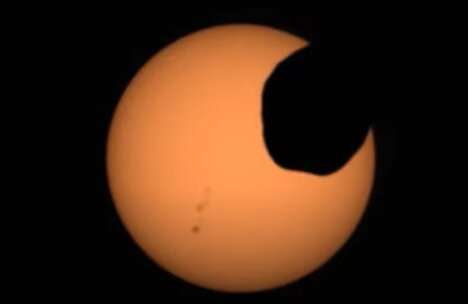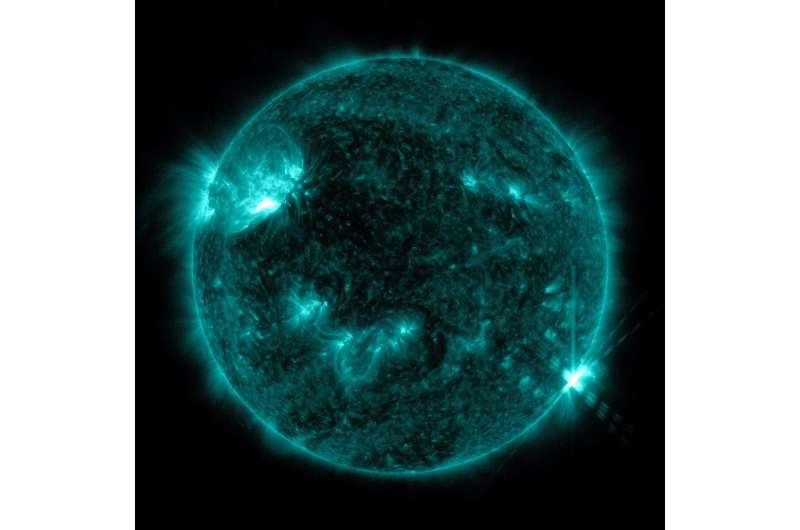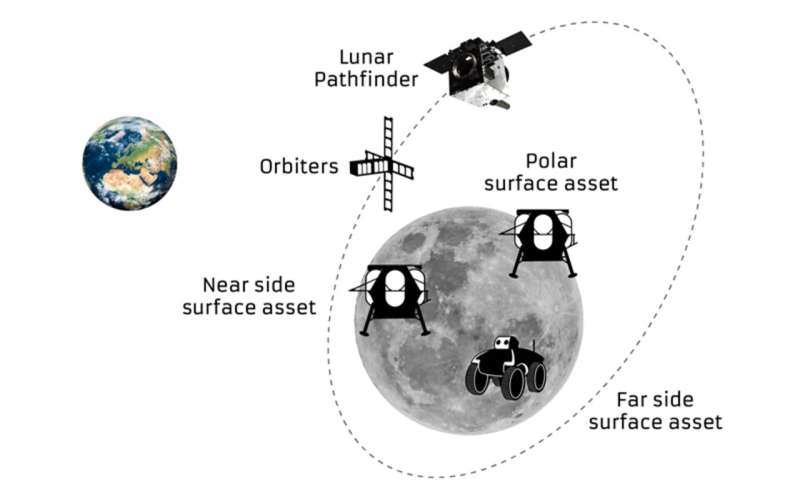
Copernical Team
California field campaign is helping scientists protect diverse ecosystems
 With a plane crisscrossing the sky and researchers working on land and sea, the Surface Biology and Geology High-Frequency Time Series campaign (SHIFT) combines the ability of airborne science instruments to gather data over widespread areas with the more concentrated observations scientists conduct in the field to study natural environments.
SHIFT is jointly led by NASA's Jet Propulsion L
With a plane crisscrossing the sky and researchers working on land and sea, the Surface Biology and Geology High-Frequency Time Series campaign (SHIFT) combines the ability of airborne science instruments to gather data over widespread areas with the more concentrated observations scientists conduct in the field to study natural environments.
SHIFT is jointly led by NASA's Jet Propulsion L Chinese satellite obtains global gravity field data
 China's Tianqin-1 satellite has acquired the global gravity field data during its in-orbit operation, according to Sun Yat-sen University in south China's Guangdong Province.
The satellite was launched in December 2019 to test the technologies of the space-based gravitational wave detection program "Tianqin." The program Tianqin, meaning "harp in the sky," was initiated by the university i
China's Tianqin-1 satellite has acquired the global gravity field data during its in-orbit operation, according to Sun Yat-sen University in south China's Guangdong Province.
The satellite was launched in December 2019 to test the technologies of the space-based gravitational wave detection program "Tianqin." The program Tianqin, meaning "harp in the sky," was initiated by the university i NASA's X-59 arrives back in California following critical ground tests
 The X-59, NASA's quiet supersonic experimental aircraft, has arrived back at Lockheed Martin's Skunk Works facility in Palmdale, California, following several months of critical ground tests in Ft. Worth, Texas.
Ground tests on the X-59 were done to ensure the aircraft's ability to withstand the loads and stresses of supersonic flight - or flight at speeds faster than Mach 1. The vehicle's
The X-59, NASA's quiet supersonic experimental aircraft, has arrived back at Lockheed Martin's Skunk Works facility in Palmdale, California, following several months of critical ground tests in Ft. Worth, Texas.
Ground tests on the X-59 were done to ensure the aircraft's ability to withstand the loads and stresses of supersonic flight - or flight at speeds faster than Mach 1. The vehicle's Will LISA see the gravity waves 10 picoseconds after the Big Bang
 The early universe may chirp about unknown physics. A University of Helsinki research team has demonstrated how an early universe phase transition will lead to gravitational wave signals potentially visible in the upcoming satellite missions. The research results were recently published in the prestigious journal Physical Review Letters.
Phase transitions, such as the boiling of water or t
The early universe may chirp about unknown physics. A University of Helsinki research team has demonstrated how an early universe phase transition will lead to gravitational wave signals potentially visible in the upcoming satellite missions. The research results were recently published in the prestigious journal Physical Review Letters.
Phase transitions, such as the boiling of water or t Space Security Challenge 2022: Hack-A-Sat 3 Registration Opens
 The U.S. Air and Space Force, in collaboration with the security research community, opened registration April 8 for the qualification round of the third annual Space Security Challenge: Hack-A-Sat satellite hacking competition.
Hack-A-Sat enables and encourages security researchers of all levels to focus their skills, creativity and innovative thinking on solving cybersecurity challenges
The U.S. Air and Space Force, in collaboration with the security research community, opened registration April 8 for the qualification round of the third annual Space Security Challenge: Hack-A-Sat satellite hacking competition.
Hack-A-Sat enables and encourages security researchers of all levels to focus their skills, creativity and innovative thinking on solving cybersecurity challenges Mars rover searches for evidence of past life at ancient river delta
 NASA's Perseverance rover, searching for evidence of past life on Mars, has completed a 31-Martian-day journey of roughly 3 miles after collecting eight rock-core samples from its first science campaign.
As of April 13, the rover was "at the doorstep of Jezero Crater's ancient Martian river delta" searching for signs of microscopic life, according to NASA.
"The delta at Jezero Cr
NASA's Perseverance rover, searching for evidence of past life on Mars, has completed a 31-Martian-day journey of roughly 3 miles after collecting eight rock-core samples from its first science campaign.
As of April 13, the rover was "at the doorstep of Jezero Crater's ancient Martian river delta" searching for signs of microscopic life, according to NASA.
"The delta at Jezero Cr NASA Crew-4 preps for launch but liftoff delayed as Ax-1 mission waits to leave ISS
 NASA's next crew of astronauts planned to launch no earlier than Saturday, but space agency officials are preparing to delay the flight because of weather problems preventing the return of Axiom Space's first mission crew from the International Space Station.
The Ax-1 crew originally planned for a 10-day mission, part of the first-ever private astronaut mission to the International Spac
NASA's next crew of astronauts planned to launch no earlier than Saturday, but space agency officials are preparing to delay the flight because of weather problems preventing the return of Axiom Space's first mission crew from the International Space Station.
The Ax-1 crew originally planned for a 10-day mission, part of the first-ever private astronaut mission to the International Spac NASA's Perseverance rover captures video of solar eclipse on Mars

NASA's Perseverance Mars rover has captured dramatic footage of Phobos, Mars' potato-shaped moon, crossing the face of the Sun. These observations can help scientists better understand the moon's orbit and how its gravity pulls on the Martian surface, ultimately shaping the Red Planet's crust and mantle.
Captured with Perseverance's next-generation Mastcam-Z camera on April 2, the 397th Martian day, or sol, of the mission, the eclipse lasted a little over 40 seconds—much shorter than a typical solar eclipse involving Earth's Moon. (Phobos is about 157 times smaller than Earth's Moon. Mars' other moon, Deimos, is even smaller.)
The images are the latest in a long history of NASA spacecraft capturing solar eclipses on Mars. Back in 2004, the twin NASA rovers Spirit and Opportunity took the first time-lapse photos of Phobos during a solar eclipse. Curiosity continued the trend with videos shot by its Mastcam camera system.
But Perseverance, which landed in February 2021, has provided the most zoomed-in video of a Phobos solar eclipse yet—and at the highest-frame rate ever.
Sun releases moderate and strong solar flares

The Sun emitted two solar flares on April 19, 2022, one moderate peaking at 9:35 p.m.
The moon, where no satnav has gone before

The test version of a unique satellite navigation receiver has been delivered for integration testing on the Lunar Pathfinder spacecraft. The NaviMoon satnav receiver is designed to perform the farthest ever positioning fix from Earth, employing signals that will be millions of times fainter than those used by our smartphones or cars.
"This engineering model of our NaviMoon receiver is the very first piece of hardware to be produced in the context of ESA's moonlight initiative, to develop dedicated telecommunications and navigation services for the moon," explains Javier Ventura-Traveset, Head of ESA's Navigation Science Office and managing all ESA lunar navigation activities.
"It will be flown aboard the Lunar Pathfinder mission into orbit around the moon, from where it will perform the furthest satellite navigation positioning fix ever made, at more than 400 000 km away to an accuracy of less than 100 m. This represents an extraordinary engineering challenge, because at such a distance the faint Galileo and GPS signals it makes use of will be barely distinguishable from background noise.

